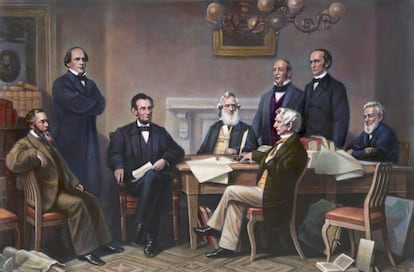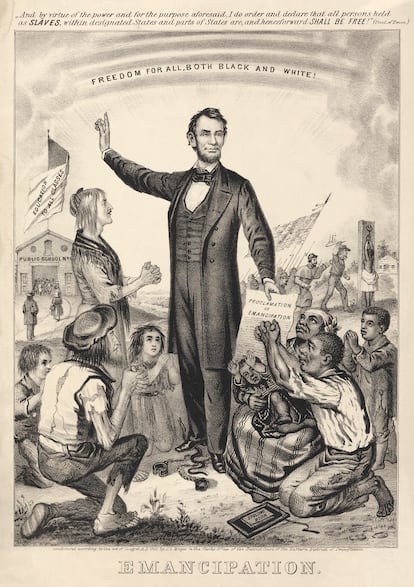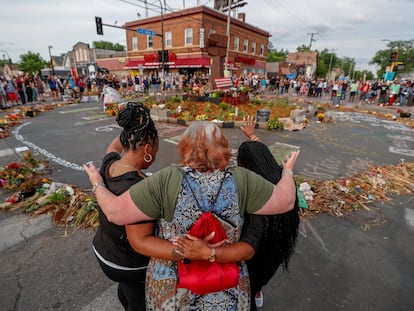The Emancipation Proclamation: the first step towards the end of slavery in the US
On September 22, 1862 President Abraham Lincoln drafted the preliminary Emancipation Proclamation, which he issued on January 1, 1863, changing the legal status of more than 3.5 million enslaved people in the Confederacy

The Emancipation Proclamation, issued by President Abraham Lincoln, was a significant part of the end of slavery in the United States and a turning point during the American Civil War.
The Civil War started because of the dispute over whether slavery would be permitted to expand into the western territories, leading to more slave states, or be prevented from doing so. Abraham Lincoln opposed slavery’s expansion and, after he was elected president in 1860, seven southern slave states responded by seceding from the United States and forming the Confederacy, which later resulted in a war with battles across the country.
The path towards emancipation
In December 1861, Lincoln endorsed legislation to address the status of contraband slaves and slaves in loyal states, possibly through buying their freedom with federal money. On March 13, 1862, Congress approved an Act Prohibiting the Return of Slaves to their owners. On April 16, 1862, slavery was abolished in the District of Columbia, and owners were compensated.
On June 19, 1862, Congress banned slavery in all current and future U.S. territories, and Lincoln signed the legislation. Later, the Confiscation Act of 1861 freed the slaves who were employed “against the Government and lawful authority of the United States,” which meant that every slave who was living under any of the Confederacy states was freed. A later version would state that “all slaves of persons who shall hereafter be engaged in rebellion against the government of the United States, or who shall in any way give aid or comfort thereto, escaping from such persons and taking refuge within the lines of the army; and all slaves captured from such persons or deserted by them and coming under the control of the government of the United States; and all slaves of such person found on [or] being within any place occupied by rebel forces and afterwards occupied by the forces of the United States, shall be deemed captives of war, and shall be forever free of their servitude, and not again held as slaves.”
Although Congress lacked the power to free the slaves in the Confederacy, Lincoln argued that he could do so if he deemed it a proper military measure.
By the summer of 1862, Lincoln had drafted the preliminary Emancipation Proclamation, which he issued on September 22, 1862. In it, Lincoln declared that on January 1, 1863, he would free the slaves in states still in rebellion. The preliminary Proclamation cited both Confiscation Acts as sources for his authority to issue the Proclamation.

The preliminary Emancipation Proclamation
In July 1862, Lincoln discussed the proclamation with his cabinet. He drafted the preliminary proclamation. Secretary of War Edwin Stanton supported the Proclamation and advised the President to issue it after a major Union victory. In September 1862, the Battle of Antietam resulted in a victory for the Union, which Lincoln seized to issue the Preliminary Emancipation Proclamation.
On September 22, 1862, Lincoln called his cabinet into session and issued the Preliminary Emancipation Proclamation. According to Civil War historian James M. McPherson, Lincoln told cabinet members, “I made a solemn vow before God, that if General Lee was driven back from Pennsylvania, I would crown the result by the declaration of freedom to the slaves.”
The final proclamation was issued on January 1, 1863, affecting South Carolina, Mississippi, Florida, Alabama, Georgia, Louisiana, Texas, Virginia, Arkansas, and North Carolina.
The Emancipation Proclamation declared the freedom of over 3.5 million enslaved individuals in the United States. Although approximately 25,000 to 75,000 people were immediately emancipated in regions of the Confederate states where the U.S. Army was present, enforcement was delayed in some areas. Texas, the most remote state of the Confederacy with 250,000 slaves, learned of the Proclamation after its issuance, but the Union army had not yet reached the state to enforce it.
The Proclamation’s full implementation came after the surrender of Confederate forces in 1865. On June 19, Union Major General Gordon Granger arrived in Galveston, Texas, to enforce the Proclamation with General Order No. 3, effectively freeing all remaining slaves in the state. While the event is celebrated as the end of slavery (today Black Americans celebrate Juneteenth on June 19), it’s important to note that emancipation in the Union border states of Delaware and Kentucky did not occur until December 18, 1865, with the ratification of the Thirteenth Amendment, which abolished slavery and involuntary servitude.
Sign up for our weekly newsletter to get more English-language news coverage from EL PAÍS USA Edition
Tu suscripción se está usando en otro dispositivo
¿Quieres añadir otro usuario a tu suscripción?
Si continúas leyendo en este dispositivo, no se podrá leer en el otro.
FlechaTu suscripción se está usando en otro dispositivo y solo puedes acceder a EL PAÍS desde un dispositivo a la vez.
Si quieres compartir tu cuenta, cambia tu suscripción a la modalidad Premium, así podrás añadir otro usuario. Cada uno accederá con su propia cuenta de email, lo que os permitirá personalizar vuestra experiencia en EL PAÍS.
¿Tienes una suscripción de empresa? Accede aquí para contratar más cuentas.
En el caso de no saber quién está usando tu cuenta, te recomendamos cambiar tu contraseña aquí.
Si decides continuar compartiendo tu cuenta, este mensaje se mostrará en tu dispositivo y en el de la otra persona que está usando tu cuenta de forma indefinida, afectando a tu experiencia de lectura. Puedes consultar aquí los términos y condiciones de la suscripción digital.
More information
Archived In
Últimas noticias
There is as much life left to discover on planet Earth as that which is already known
Dozens presumed dead, around 100 injured in fire at Swiss Alps bar during New Year’s celebration
Is porn for women different from conventional porn? We spoke to those who make it
Cartagena de Indias is sinking: What can the city do to mitigate it?
Most viewed
- Reinhard Genzel, Nobel laureate in physics: ‘One-minute videos will never give you the truth’
- David King, chemist: ‘There are scientists studying how to cool the planet; nobody should stop these experiments from happening’
- Sinaloa Cartel war is taking its toll on Los Chapitos
- Oona Chaplin: ‘I told James Cameron that I was living in a treehouse and starting a permaculture project with a friend’
- The Interoceanic Train, the Mexican alternative to the Panama Canal










































